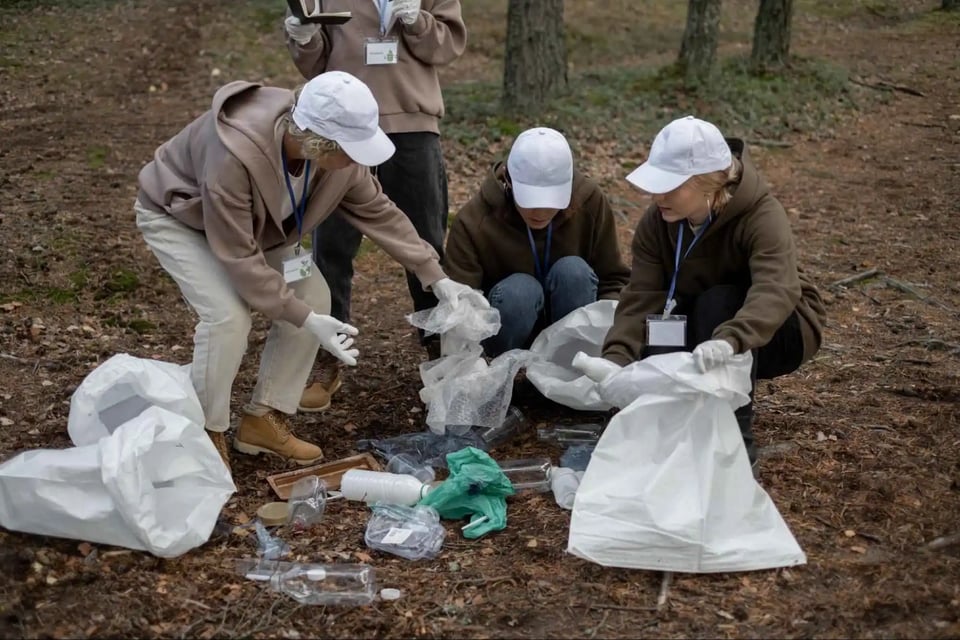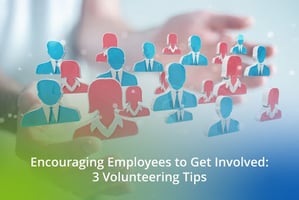Did you know that volunteering makes us happier? Research shows that volunteering boosts people’s...
What is the New Normal for Corporate Volunteering?
COVID pandemic practices and policies forced the world to create a “new normal”. Workplace and workflow habits were reinvented, as were nearly all of our traditional ways of participating in society. The realm of corporate volunteering was no exception.
Corporate volunteering more or less followed a very specific formula before the pandemic. A company would conceptualize volunteer events, such as clean-ups at local parks or mentoring opportunities with local after-school programs, identify a partner organization to host it, and invite the corporate employee community to participate together, in person. Many corporations would identify, “value pillars,” or a handful of cause-area themes, the executive team felt aligned with the company’s values. Employees may have been compelled to volunteer, with offers of paid time off, matching gifts, or a hope of a positive nod from management.
Not everyone was participating, though. Actually, before the COVID pandemic, only around 33% of employees participated in employee volunteer programs. Of course, many more would have liked to participate under different circumstances.
The problem had been that these events did not feel personally relevant enough. They had not been conceived from the multitude of perspectives of employees - they’d simply followed a pattern of top down thinking along the lines of, “This year, our Company stands for mental health,” or a similarly broad, one-size-fits-all directive to which partner nonprofits had been directed to conform if they hoped to receive corporate grants in return for hosting events.
Jessica Rodell surveyed people who chose not to volunteer with United Way programs across 50 companies (Harvard Business Review). The two top reasons for employees not volunteering were because the projects were seemingly not flexible or personally meaningful enough to pursue. The opportunities presented were instead perceived as pet initiatives of their directors or company CSR team.
The best companies already understood these tendencies before the pandemic, and started diversifying their corporate volunteering strategies accordingly. They started allowing employee teams to guide the volunteering process, to work together to select meaningful opportunities that aligned within a looser framework of corporate values. These unofficial team leaders are sometimes referred to as, “Champions.”
The COVID pandemic then pushed companies to take program diversification to another level, by improving flexibility within corporate volunteering structures. In-person events wouldn’t work, so they had to shift gears to enable remote, virtual, and distributed options to advance the same activities that used to require physical gathering. The Great Resignation has now led companies to treat flexibility as a core requirement in order to help recruit and retain employees, whether they work in headquarters, retail locations, or remotely. Top talent may even make a decision on whether or not to work for a company based on the corporate volunteering program.
What does all of this mean, especially for volunteer managers? How can companies navigate this new normal while effectively designing volunteer programs and managing their volunteers within them to fulfill employee teamwork and personal satisfaction goals, as well as CSR impact goals?
The transition to digital in corporate volunteering
Of course, during a period of near-universal social isolation, there was a steep decline in physical volunteering. Almost all non-mission-critical, in-person events were canceled everywhere in the world. That new normal was an adjustment for everyone, and varied depending on individual circumstances - especially for isolated, vulnerable, disenfranchised, differently-abled, low income, and minority populations. New technology tools have developed during the past few years to make corporate volunteering easier and also to help companies develop new tools to keep up with the evolving status quo and to do so in an equitable way that benefits all stakeholders.
Though volunteers switched to working digitally during the pandemic, they did and still do yearn to join in-person activities. Companies, nonprofits, and other CSR organizers should take the opportunity to digitally transform, streamline, and diversify the structures of their volunteering programs using the many, flexible features within volunteer platforms in order to meet their stakeholders where they are. Participation in these programs will massively and sustainably improve as a result.
Golden’s platform, for example, can help your nonprofit organization or company automate your administrative processes within your corporate volunteering program. This includes mirroring your pre-existing processes, roles, permissions, campaigns, audiences, partners and other considerations, all within point-and-shoot websites and apps that work on any device anywhere in the world. Just a few of the functions of the software platform that help include:
- Finding and vetting causes that align with your CSR and employee interests.
- Identifying appropriate opportunities for your Employee Resource Groups and / or Companies with whom you partner.
- Promoting activities seamlessly to your work teams by click-to-recommend workflows.
- Managing group signups and onboarding for team members in a single time or sequence of opportunity times.
- Handling logistics, such as schedules and automated check-in and checkout at events.
- Tracking the hours that your employees log and their impact measurement (like pounds of trash collected and progress toward United Nations SDG’s) in real time.
- Celebrating the volunteer team and rewarding them with special benefits.
- Complying with relevant laws and regulations, including necessary background checks for volunteers.
- Organizing training sessions online to minimize time spent out of the office.
Including diverse participants requires presenting diverse volunteer opportunities
Gen Z wants to volunteer for radically different reasons and in radically different ways than Greatest Generation, Baby Boomer, Gen X, and Millennial volunteers do.
In fact, younger generations from which your company may be focusing recruitment are keen on working for companies that have meaningful volunteering programs aligned to the core of the company identity. This means that, to meet these employees where they are, you must consider personalization and not simply offer one or two events that align with management’s goals.
Volunteer management software can again help here.
-
-
-
- A platform like Golden’s can help you link “value pillars” or thematic interests across partner organizations and like-minded non-profits. This way, you can select opportunities and create portfolios of extremely different volunteering opportunity types to appeal to your wide audience of potential volunteers, while staying true to company strategies. You will still be able to measure the impact toward your goals while offering a diverse range of experiences.
- Team members, themselves, can use the platform to become champions of different causes that align with your pillars and values. Golden makes it easy for anyone on the platform to organize their own events or piggy-back off of other events from relevant organizations.
- You can go beyond customary “days of service” to allow for continuous volunteering opportunities in more flexible locations and in more flexible ways than you have in the past - allowing anyone anywhere in your organization to find a place where they can comfortably contribute to shared objectives.
-
-
Try Golden, the world's most awarded volunteer platform, and navigate the new normal!
When investing in volunteering programs is more than just a charitable contribution
Companies have long championed corporate volunteering for the CSR benefits it can provide. This has only become more important in recent years, as younger generations insist on social impact demonstration from their brands and from the companies where they work. Beyond these considerations, there is also a lot of ground to gain - from a sense of camaraderie and belonging, to increased skills and confidence, service isn’t something separate from the core of a company, it is simply the personal expression of a company’s sense of purpose.

Corporate volunteering improves soft skills such as leadership development, team work, and communication. Working together as a team or simply under a culture of shared values can strengthen company loyalty along with your human resource capacity.
Most importantly, corporate volunteering makes people happier. That makes people working for you happier. It releases endorphins and minimizes loneliness, while reducing anxiety and depression. People will take less sick days and be more productive.
Volunteer management platforms can help you organize your opportunities not only for impact, to make employees feel they are valuable (another positive reward from volunteering), and also create employee resource groups (ERGs) to help isolated individuals feel more valued as part of a cohort. This is even more important for the employees who have remained in digital roles, isolated from office water cooler interactions.
This is part of the reason why Golden has been featured by Apple as one of the best apps for mental health — not only among volunteering software systems but across all apps. It’s an amazing platform to connect your isolated employees and to help your teams feel impactful and appreciated.
Thriving in the new normal for corporate volunteering doesn’t have to be so hard
The biggest takeaway for the new normal of corporate volunteering is to lean into diversity — the diversity of your staff, your broader sets of stakeholders, and the underrepresented people you’d like to include in your efforts. Celebrate their values, and enable their preferred living and working styles. It is important to listen to the voices of staff and understand what they want in a volunteer program. Building a volunteer program from the bottom up, based on ground-level interest, combined with top down guidance around priority issues, is the best practice.
The help of a great technology tool like Golden is also a new normal for corporate volunteering programs that follow these successful models. Software can help you streamline administrative processes and automatically track impact metrics. Most importantly, it can provide simpler ways for you to offer flexible, fun, and impactful ways for your employees to contribute that match with your corporate volunteering impact goals.
It can even help you build a baseline culture of contribution by offering communal rewards and promoting group recognition. Golden is one of the only software management tools that integrates its own rewards system, Karats (a FastCompany “World-Changing Idea”), so that volunteers across organizations and platforms have chances for recognition and prizes.
This type of recognition, along with ensuring that your employees have chances for meaningful engagement, has a real value. One study showed that middle-class salaried workers in the United Kingdom were happier after volunteering than earning £1,100 more in a year. If employees are happier, they focus less on the other “rewards” of their work, including monetary compensation.
Corporate volunteering may have shifted quickly after the COVID pandemic began, but seemingly only for the better!


